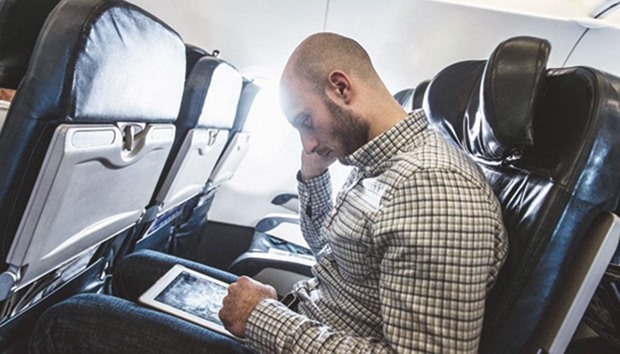A ban on large carry-on electronics on some international flights lays bare a high-stakes scientific battle between militant groups and security chiefs that has already dramatically altered airline travel, especially since the September 2001 attacks in the United States.
Security experts say the decision to place devices bigger than a cellphone into checked bags on US-bound flights from eight Middle East or North African states suggests Washington believes enough material can be packed in a laptop, usually disguised as its battery, to cause catastrophic damage.
Most experts agree today’s ever-thinner smartphones make it harder to hide enough explosive to down a large aircraft, but that they can be used to detonate devices located elsewhere.
The ban does not mean a powerful laptop-hidden explosive device would usually be any safer if it got into the hold, even though there has been research onto stronger bag containers.
But checked baggage is subject to screening in more controlled conditions, including explosives checks at US and many foreign airports and the use of sniffer dogs which remain one of the most effective ways of detecting most types of bomb.
Ordinary X-ray machines of the type widely used to scan carry-on bags are less able to spot explosives which may have similar density to batteries.
They are supplemented with machines to analyse a piece of cloth swiped over hands or bags at random or when needed but these do not cover all passengers.
There is a slender hope that a bomb smuggled in checked baggage could be harder to trigger manually than in the cabin, and also harder to place in a vulnerable location next to the fuselage skin, unless a baggage handler worked as an accomplice.
A suspected suicide bomber tried to blow up a Somali Airbus after it took off from Mogadishu last year using a computer bomb near the window, but he was sucked out of the jet without causing it to crash.
But while preventing manual detonation may deter some groups, it would not prevent sophisticated triggering techniques believed to have been perfected by Al Qaeda and affiliated groups.
Some expect the United States, which usually moves faster than the rest of the world in these matters, to modify the rules over time as more airports review their screening practices.
“The US strategy is usually to kill the risk, without waiting for global agreement,” a Western security source said.
But the source acknowledged the rules “make no difference if you can get (a device) on board and trigger it remotely.”
Tuesday’s clampdown is not the first time carry-on objects have been limited according to their size.
Since 2006, liquids bought outside a secure area have been restricted to 100ml bottles after the UK foiled a plot to bomb US-bound flights using explosives disguised as soft drinks.
Security experts say the strategy is to direct virtually all efforts towards preventing any harmful devices getting on the plane, but as a fallback to limit risky materials brought inside the cabin to levels that might limit potential damage.
While Wednesday’s car and knife attack outside the UK parliament confirmed the effectiveness of crude weapons on the ground, laptops have become central in an ever-more sophisticated battle over airline security as militants try to develop usable explosives that can evade modern detection.
But the terms of this struggle are changing constantly.
In 2014, after Al Qaeda published recipes for a “hidden” bomb, passengers were asked to turn on their devices before boarding to prove the battery was real.
Bombmakers responded by experimenting with just enough extra battery to pass the test.
And an attack on an airport from publicly accessible areas like those seen in Brussels or Istanbul remains “far more likely” than an onboard detonation, according to Jonathan Wood, a director of UK consultancy Control Risks.
Headaches over shifting security measures don’t end there.
Although computer battery compartments and DVD drives have previously been identified as a security risk, it is only recently that regulators have also had to balance that against the risk of fire hazards from genuine lithium-ion batteries.
Some experts warn placing computers in the hold, often poorly packed, could generate new safety risks – concerns echoed by a United Nations agency late on Wednesday.
One problem is that while aviation has a well-tried mechanism for agreeing safety standards worldwide, security and counter-terrorism tend to be discussed in secret.
In 2011, Washington privately ordered US carriers to disable emergency oxygen systems in the toilets of most airplanes because they depended on chemicals including potassium, which could be used to make a bomb.
But it also temporarily put airlines at odds with US safety law, because it meant that passengers going to the bathroom during a US flight could risk hypoxia in the event of depressurisation.
Meanwhile, passengers still in their seats would grab masks fed by a different kind of oxygen system.
The Federal Aviation Administration rejected complaints that safety worries outweighed security, but later softened its recommendations as long as the devices were made tamper-proof.

Laptops have become central in an ever-more sophisticated battle over airline security.


